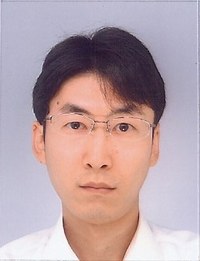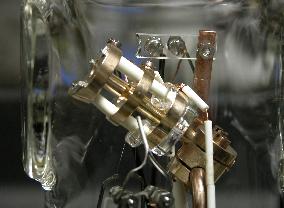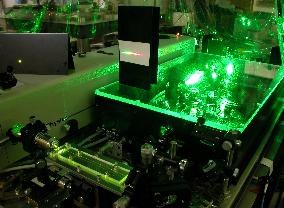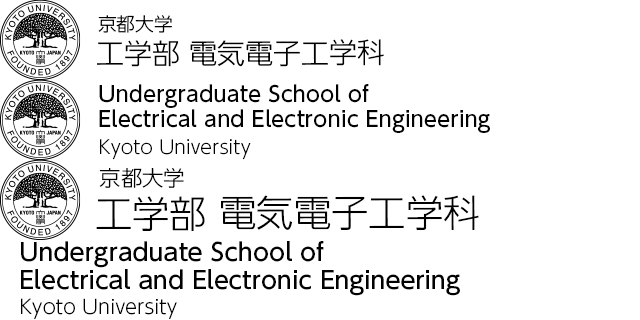Quantum Optical Engineering
If quantum phenomena are utilized effectively, it may be possible to conduct unimaginably high-precision measurements. The extremely high precision of one such application—atomic clocks, whose operation is based on the interaction between atoms and electromagnetic waves—is utilized in real-world, day-to-day applications such as GPS devices. We are pursuing research that explores further improving this precision, by using laser light to attempt to create an atomic clock that remains accurate to within one second over vast cosmological spans of time. We are also studying the development of an optical frequency synthesizer that references this kind of super-stable laser frequency to freely generate laser light and microwaves of different wavelengths with ultra-high precision.
We also study control of electromagnetic waves using assembly of artificial sub-wavelength structures, called "metamaterials." The metamaterials enable us to realize extraordinary electromagnetic responses, such as negative refraction. Owing to the scalability of metamaterials, the design of the metamaterials can be applied to any frequency regions from microwave to optical regions. In our laboratory, we explore novel electromagnetic responses by designing the artificial structures in electromagnetic simulations, and experimentally demonstrate the extraordinary phenomena of the metamaterials in microwave and terahertz regions.
Academic Staff
Kazuhiko SUGIYAMA
 Associate Professor (Graduate School of Engineering)
Associate Professor (Graduate School of Engineering)
Research Interests
Quantum Electronics, Quantum Measurement
Ultra-high-precision measurement using quantum phenomena, including
- Laser (optical) atomic clocks and quantum computers with single or array of ions.
- Optical and microwave frequency synthesizers with ultra-fast mode-locked lasers.
Classes
- Electronics
- Quantum Measurement (Grad. School)
Contacts
Kyoto Univ. -Katsura, A1-124
TEL: +81-75-383-2322
FAX: +81-75-383-2324
E-mail: sugiyama kuee.kyoto-u.ac.jp
Toshihiro NAKANISHI
 Senior Lecturer (Graduate School of Engineering)
Senior Lecturer (Graduate School of Engineering)
Research Interests
metamaterials, quantum electronics, nonlinear optics
Contacts
TEL: +81-75-383-2323
FAX: +81-75-383-2324
Introduction to R&D Topics
Single or string of ions in traps
A single ion confined by an electric field within a small region with an ultra-high vacuum can be maintained at rest by laser cooling. Since the single ion is isolated from its surroundings and exhibits the essential characteristics of an ion, it is possible to determine the frequency of the light the ion absorbs with extremely high accuracy. By stabilizing the frequency of a laser using this as a reference frequency, we are doing research aimed at developing an extremely accurate atomic clock that operates in the visible region. We have also commenced research aimed at developing a quantum computer using a small number of ions that have been cooled down to crystallize into a string.

Optical frequency synthesizers
Ultra-short pulsed lasers known as "mode-locked lasers" can emit light pulses at time intervals of extremely high accuracy. If a Fourier transform is applied to the frequency axis of the signal, the result is equivalent to an aggregate of a large number of continuous-wave lasers oscillating at different frequencies at a fixed frequency interval. This waveform is known as an optical-frequency comb due to its shape, and it can be used like the graduations of a ruler for measuring optical frequency. Furthermore, if these light pulses are propagated along a special optical fiber known as a photonic crystal fiber, the spectral bandwidth of the optical frequency comb expands to more than one octave. Using an optical frequency comb having a spectral bandwidth of more than one octave it is possible to correlate the frequency of each mode (visible region) of the comb with the comb's mode interval (microwave region), thereby enabling the frequencies of visible light and microwaves to be directly compared. Our research in this area is focused on optical frequency measurement systems based on GPS clocks, optical frequency synthesizers that generate laser outputs of arbitrary wavelength, and the development of stable, accurate microwave sources of accurate division of laser frequencies of which stability are superior to those of masers. We are particularly focused on applications such as the development of small atomic clocks (laser atomic clock) utilizing semiconductor lasers.

Metamaterials
The response of materials that exist in the natural world to magnetic fields is extremely small, and the relative permeability of natural materials relative to microwave or light is effectively considered to be 1. However, the magnetic response of artificially created structural materials, known as "metamaterials," can be varied very significantly. Metamaterials can exhibit peculiar characteristics, such as negative refractive indices, whereby electromagnetic wave is bent in a "<" shape at the interface of the material. In our laboratory, we investigate storage and electromagnetic waves in metamaterials, and study the control of terahertz waves using two-dimensional metamaterial, or metasurface.

